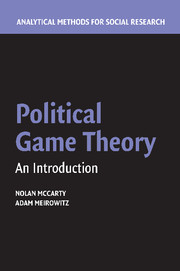Book contents
- Frontmatter
- Contents
- Acknowledgments
- 1 Introduction
- 2 The Theory of Choice
- 3 Choice Under Uncertainty
- 4 Social Choice Theory
- 5 Games in the Normal Form
- 6 Bayesian Games in the Normal Form
- 7 Extensive Form Games
- 8 Dynamic Games of Incomplete Information
- 9 Repeated Games
- 10 Bargaining Theory
- 11 Mechanism Design and Agency Theory
- 12 Mathematical Appendix
- Bibliography
- Index
8 - Dynamic Games of Incomplete Information
Published online by Cambridge University Press: 05 June 2012
- Frontmatter
- Contents
- Acknowledgments
- 1 Introduction
- 2 The Theory of Choice
- 3 Choice Under Uncertainty
- 4 Social Choice Theory
- 5 Games in the Normal Form
- 6 Bayesian Games in the Normal Form
- 7 Extensive Form Games
- 8 Dynamic Games of Incomplete Information
- 9 Repeated Games
- 10 Bargaining Theory
- 11 Mechanism Design and Agency Theory
- 12 Mathematical Appendix
- Bibliography
- Index
Summary
In Chapter 6, we learned that uncertainty about the preferences of other players fundamentally alters the strategic situation in static normal form games. In dynamic, multistage games uncertainty leads to even more interesting strategic possibilities. Reconsider the revolution game depicted in Figure 7.1. The unique subgame perfect equilibrium involves a revolt by the colony and the grant of independence, (R, (G, T)). Now consider the game depicted in Figure 8.1. In contrast with the game of Figure 7.1, nation B incurs no cost from using force to suppress a revolution.
Now the unique subgame perfect equilibrium is (C, (S, T)). This chapter addresses the following question: How should nation A behave if it is not sure which figure accurately describes the game?
We now consider games in which players face uncertainty about preferences of other players. Games of this form involve incomplete information. As in Chapter 6, we model such uncertainty using the Harsanyi maneuver. Uncertainty about the payoffs of other players is modeled as a game in which players are uncertain about which node of the game they are located on. This trick involves the use of a fictitious player – Nature – who randomly selects players' types from a known probability distribution. Not all players, however, observe the realization of Nature's draw. To model a situation in which player i does not know player j's preferences, we assume that Nature chooses player j's payoffs (type) prior to agent i's decision, and we model player i as facing an information set with multiple nodes because she does not observe the choice by Nature.
- Type
- Chapter
- Information
- Political Game TheoryAn Introduction, pp. 204 - 250Publisher: Cambridge University PressPrint publication year: 2007

